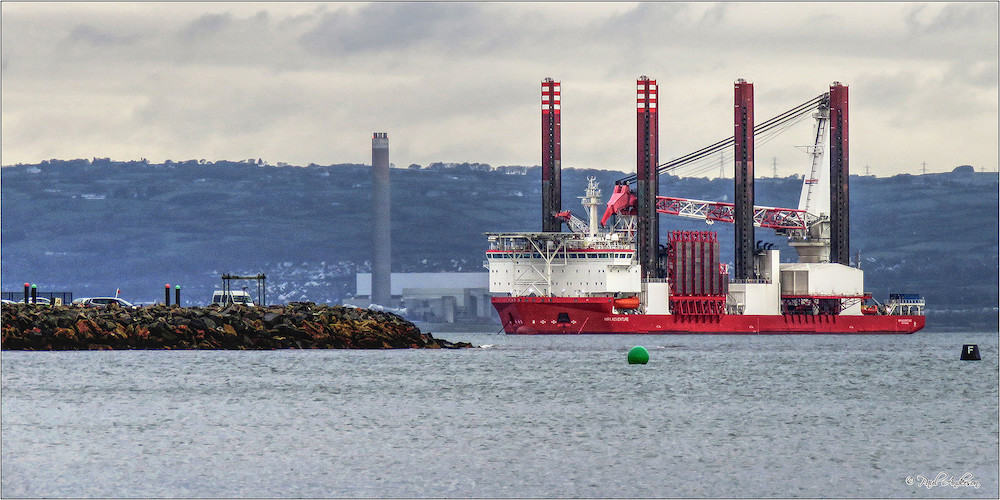
[Image above] MPI Adventure, a wind turbine installation vessel, anchored off Luke’s Point, Bangor, Belfast Lough. Credit: BangorArt, Flickr (CC BY-NC-ND 2.0)
When faced with the energy crisis of the 1970s, key United States government personnel and agencies projected that the sun’s “huge and virtually inexhaustible potential supply of energy” would likely serve as a mainstay of the energy industry in the future. Fifty years later, it is instead wind energy that has come to play a significant role, accounting for about 8% of U.S. electricity generation in 2020 in contrast to solar power’s approximately 2%.
Investment in wind energy is not the only aspect of the industry that’s increasing—the size of wind turbines is as well.
Since the early 2000s, wind turbines have grown significantly in terms of both physical measurements and energy generation capacity. For example, as noted on the Department of Energy’s Office of Energy Efficiency & Renewable Energy website, the hub height for utility-scale land-based wind turbines increased from an average 98 feet to 295 feet in the last 30 years, while the turbine’s rotor diameter (width of the circle swept by the rotating blades) increased from an average 89 feet to 410 feet during that same timespan. Likewise, maximum power rating, or capacity, increased from an average 0.2 MW to 3 MW.
Offshore wind turbines are projected to grow even more than their land-based counterparts—from 328 feet in 2016 to up to 495 feet in 2035, with a rotor diameter of 820 feet and power rating of 17 MW.

Illustration of increasing turbine heights, blades lengths, and energy generation capacity over time. Credit: Office of Energy Efficiency & Renewable Energy
While these increasingly large turbines excel at generating more energy, they also result in more waste upon decommissioning, an issue we’ve covered in past CTTs. Yet there is another issue for super-sized turbines that we haven’t touched on yet—the issue of transportation.
As shown in the video below, ships are used to transport the components of a wind turbine to the offshore location, where it is then assembled. Current state-of-the-art installation vessels can transport up to four 8-MW-class wind turbines at a single time.

Credit: SiemensGamesa, YouTube
While these capabilities are sufficient for transporting wind turbines today, the move toward larger wind turbines will soon surpass the limits of current vessels.
“Turbines larger than 8 MW accounted for just 3% of global installations between 2010 and 2021, but that percentage is forecast to surge to 53% by 2030,” explains a new report by independent energy research and business intelligence company Rystad Energy.
In the report, Rystad Energy looks at how the installation of super-sized offshore wind farms could face bottlenecks in the coming years if operators do not invest in new vessels capable of transporting the massive turbines.
The report notes that only a handful of vessels currently exist that can install 10 MW+ turbines; none can install 14 MW+ turbines. However, the high cost of manufacturing a new installation vessel—$300–$500 million for one that can handle 14 MW+ wind turbines—makes it difficult for developers to finance the necessary ships, as they would need several offshore wind builds in sequence to get a return on their investment.
Contrast these costs with the rising demand for offshore wind installations and “There simply is not enough time to ramp up domestic capacity prior to an initial wave of offshore wind facilities being constructed,” says Heather Zichal, CEO of American Clean Power Association, in written Congressional testimony presented last year to the U.S. House Committee on Foreign Affairs Subcommittee on Europe, Energy, the Environment and Cyber.
Taken together, Rystad Energy proposes that these factors may culminate in a slowdown in offshore wind installations in the coming years.
While the report describes the work by some companies to expand their carrying capacity through either new builds or upgrades of existing vessels, researchers are also exploring alternative ways to transport super-sized wind turbines that do not require massive ships.
For example, in 2017, researchers led by the University of Delaware investigated the possibility of assembling a wind turbine in port mounted on caissons, then lashing the entire structure to the side of a vessel or barge and hauling it to location. While this approach would allow for the use of smaller, lower-cost vessels, no ports currently exist that allow for this kind of onshore assembly.
Author
Lisa McDonald
CTT Categories
- Energy
Related Posts
‘Fairy circles’ may help mark natural underground hydrogen deposits
September 18, 2025


